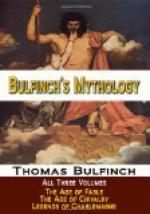“The cause some say is this.
A little while
Before that Merlin died, he
did intend
A brazen wall in compas to
compile
About Caermerdin, and did
it commend
Unto these sprites to bring
to perfect end;
During which work the Lady
of the Lake,
Whom long he loved, for him
in haste did send;
Who, thereby forced his workmen
to forsake,
Them bound till his return their labor
not to slack.
“In the mean time, through
that false lady’s train,
He was surprised, and buried
under beare,
He ever to his work returned
again;
Nathless those fiends may
not their work forbear,
So greatly his commandement
they fear;
But there do toil and travail
day and night,
Until that brazen wall they
up do rear.
For Merlin had in magic more
insight
Than ever him before or after living wight.”
[Footnote: Buried under beare. Buried under something which enclosed him like a coffin or bier.]
CHAPTER IV
ARTHUR
We shall begin our history of King Arthur by giving those particulars of his life which appear to rest on historical evidence; and then proceed to record those legends concerning him which form the earliest portion of British literature.
Arthur was a prince of the tribe of Britons called Silures, whose country was South Wales, the son of Uther, named Pendragon, a title given to an elective sovereign, paramount over the many kings of Britain. He appears to have commenced his martial career about the year 500, and was raised to the Pendragonship about ten years later. He is said to have gained twelve victories over the Saxons. The most important of them was that of Badon, by some supposed to be Bath, by others Berkshire. This was the last of his battles with the Saxons, and checked their progress so effectually, that Arthur experienced no more annoyance from them, and reigned in peace, until the revolt of his nephew Modred, twenty years later, which led to the fatal battle of Camlan, in Cornwall, in 542. Modred was slain, and Arthur, mortally wounded, was conveyed by sea to Glastonbury, where he died, and was buried. Tradition preserved the memory of the place of his interment within the abbey, as we are told by Giraldus Cambrensis, who was present when the grave was opened by command of Henry ii. about 1150, and saw the bones and sword of the monarch, and a leaden cross let into his tombstone, with the inscription in rude Roman letters, “Here lies buried the famous King Arthur, in the island Avalonia.” This story has been elegantly versified by Warton. A popular traditional belief was long entertained among the Britons, that Arthur was not dead, but had been carried off to be healed of his wounds in Fairy-land, and that he would reappear to avenge his countrymen and reinstate them in the sovereignty of Britain. In Warton’s “Ode” a bard relates to King Henry the traditional story of Arthur’s death, and closes with these lines.




